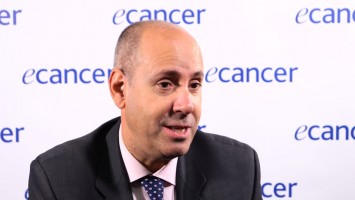The rationale for the study is that we know that BRCA mutated tumours are very sensitive to platinum salts. Moreover, these kinds of tumour are a good candidate to PARP inhibition according to the concept of synthetic lethality. So there is a strong rationale to combine both platinum and PARP inhibitors. However, in the past the studies demonstrated high toxicity combining these two agents perhaps because of the trap activity of some PARP inhibitors. Veliparib inhibits PARP but with a low PARP trapping activity. In a first phase II trial we did observe a numerical increase in PFS and overall survival with the addition of veliparib to platinum therapy and this deserved a larger phase III trial.
What we did, in fact we compared veliparib carboplatin paclitaxel versus placebo carboplatin and paclitaxel in 500 patients randomised with a ratio of two to one. But important to note in this trial patients discontinuing cytotoxic chemotherapy due to toxicity received veliparib placebo monotherapy. Moreover, in the placebo arm at progression there was a further crossover to veliparib. The primary objective of the trial was the median PFS and the primary endpoint was met with an increment of two months and statistically significant. Moreover, it was very important to highlight the fact that the benefit was durable as we did observe in the veliparib arm more patients progression free and alive at two years and at three years.
Then after the secondary endpoint, of course, is overall survival. The data are not mature but with a median follow-up of 36 months the median overall survival in the veliparib arm is almost three years. So it’s very encouraging in this population of patients with BRCA mutation advanced breast cancer.
Were there any adverse events?
Considering these two classes of agent, platinum and PARP inhibitor, of course we were cautious about myelosuppression. In fact, the main toxicity was anaemia, thrombocytopenia and neutropenia. However, less than 10% of the patients discontinued the treatment due to toxicity. It was very well manageable and we did observe very few serious adverse events, as infection less than 5% and bleeding less than 1% in the veliparib arm.
What could be the implications of this?
The first time we were able to combine a PARP inhibitor on the platinum front. The key point of this trial is the fact that the control arm is highly effective with almost one year PFS, median PFS, in the control arm. The first time we did observe such an improvement in PFS in such a population. So, in fact in my opinion, patient candidates to chemotherapy with a germline BRCA mutation advanced breast cancer should be offered this treatment option.
Where do we currently stand with PARP inhibitors in metastatic breast cancer?
Today in metastatic breast cancer we have the proof of concept of activity in patients harbouring BRCA mutations. With the OlympiAD study with olaparib olaparib was better than treatment of physician’s choice chemotherapy but without platinum in this control arm, as the EMBRACA study with talazoparib – again, improvement in median PFS so active drugs. But in these two main phase III trials the median PFS was between 7-8 months. So this is active but with the addition of platinum in our trial, in the BROCADE-3, the median PFS is 14.5 months. So we can, of course, do a cross trial comparison but the improvement in the duration of the benefit is very important.
The next step will be, of course, the evaluation in the early setting and we are expecting the data of the OlympiAD study in the adjuvant setting with olaparib.








